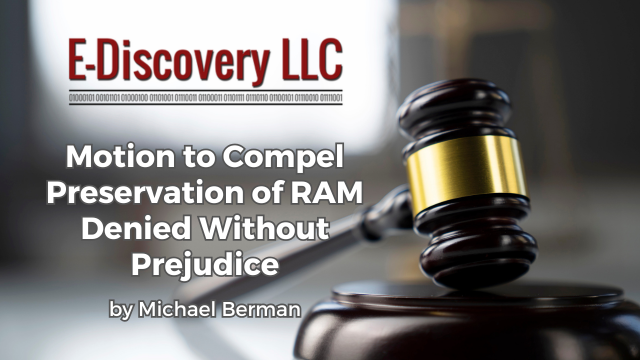
[EDRM Editor’s Note: The opinions and positions are those of Michael Berman.]
The federal court in Delaware has a “Default Standard for Discovery, Including Discovery of Electronically Stored Information.” Belvac Production Machinery, Inc. v. Adonis Acquisition Holdings LLC, 2025 WL 2146099 (D. Del. Jul. 29, 2025). It applied that standard to a request to preserve information in Random Access Memory (“RAM”).
Belvac sought preservation of information in the RAM of Adonis computers and requested entry of an ESI Protocol to that effect. Adonis disputed feasibility and proportionality. Applying its Default Standard, the Belvac court concluded that the parties needed to confer more and held, without prejudice, that Belvac had not shown good cause.
Belvac sought preservation of information in the RAM of Adonis computers and requested entry of an ESI Protocol to that effect.
Belvac Production Machinery, Inc. v. Adonis Acquisition Holdings LLC, 2025 WL 2146099 (D. Del. Jul. 29, 2025).
COLUMBIA PICTURES v. BUNNELL
Although not cited in Belvac, in 2007, a court wrote: “At the heart of Defendants’ Motion for Review is the following question of first impression: is the information held in a computer’s random access memory (RAM) ‘electronically stored information’ under Federal Rule of Civil Procedure 34?”
In that case, the court held that “data held in the RAM of computers under Defendants’ control is within the scope of discoverable information…” Columbia Pictures, Inc. v. Bunnell, 245 F.R.D. 443, 448 (C.D. Cal. 2007).
Columbia Pictures sued a website operator that permitted downloads of copyrighted pictures. Defendants argued that information stored in RAM was too temporary to be considered discoverable ESI.
The [Columbia Pictures] Court finds this interpretation of “stored” unsupported by the text of the Rule, the accompanying commentary of its drafters, or Ninth Circuit precedent involving RAM. The Court holds that data stored in RAM, however temporarily, is electronically stored information subject to discovery under the circumstances of the instant case.
Id. at 446.
In response to arguments that compliance would be “potentially devastating,” the Columbia Pictures court described the narrow contours of its holding and ordered that defendants “begin preserving and subsequently produce a particular subset of the data in RAM under Defendants’ control.” Id. at 448.
BELVAC v. ADONIS
In Belvac, Belvac alleged that Adonis “is reproducing Plaintiff’s copyrighted software in random access memory (‘RAM’) or other temporary storage in violation of the Copyright Act.” Belvac asked the court to enter an ESI Protocol that required preservation:
To obtain the evidence necessary to support its claims, Plaintiff seeks the entry of a protocol to govern the preservation and production of electronically stored information (“ESI”) in this case…. Defendant opposes Plaintiff’s proposal, arguing that Plaintiff has not shown good cause to deviate from the court’s Default Standard.
Id. at *1.
The Belvac court wrote that there was agreement that a “good cause” standard governed its analysis.
The District of Delaware’s Default Standard for Discovery, Including Discovery of Electronically Stored Information (the “Default Standard”), governs the preservation of discoverable information. The Default Standard states that, “[a]bsent a showing of good cause by the requesting party, the parties shall not be required to modify, on a going-forward basis, the procedures used by them in the ordinary course of business to back up and archive data; provided, however, that the parties shall preserve the non-duplicative discoverable information currently in their possession, custody or control.” D. Del. Default Standard, ¶ 1(c)(i).
Id.
The Belvac court explained that:
The Default Standard also identifies a list of specific categories of ESI which need not be preserved absent a showing of good cause. Id. at ¶ 1(c)(ii). Among this list are three categories of ESI relevant to this dispute: (a) deleted, slack, fragmented, or other data only accessible by forensics; (b) random access memory (RAM), temporary files, or other ephemeral data that are difficult to preserve without disabling the operating system; and (c) server, system, or network logs. Id.; Schedule A at ¶¶ 1, 2, & 11.
Id.
Belvac asked the court to compel preservation of those three excepted categories, only “to the extent that this information evidences use, reproduction, preparation of a derivative work, and/or distribution of the Belvac Software by Defendant….” Id.
Belvac argued that, every time Adonis powered on or rebooted equipment, a copy of Belvac’s copyrighted software was made to RAM and retained only until it was powered off. Belvac contended that Adonis “need only perform real-time retention when it is conducting one of the enumerated reproductive acts,” and that preservation was needed only if it evidenced an alleged infringing act. Id. at *2.
Adonis argued that Belvac had “not fully engaged” in a meet-and-confer, and the court ordered additional discussions. The court added:
Adonis disputes that “real-time” capture of RAM is even possible, noting that “the only programs Adonis has been able to identify … create a snapshot at the time the capture is initiated. This snapshot would not be a continuous capture of RAM over time.” … Furthermore, Defendant knows of no tool to capture snapshots of RAM in Rockwell PLCs and the PLCs do not create temporary files. Therefore, Defendant contends that there is no ESI in this category that could be preserved on the PLCs.
Id.
Adonis also asserted “that the breadth of the preservation requirement would cause delays in production when Defendant needs to contact an outside vendor each time the equipment is rebooted or serviced.”
Adonis estimated that “the cost of the proposed preservation would total between $40,000 and $240,000, depending on certain variables,” however, the court saw “no evidence beyond a brief declaration to substantiate these estimates.”
The Belvac court wrote: “The record before the court suggests that Defendant did not investigate the cost, feasibility, or burden of implementing Plaintiff’s proposal prior to the parties’ meet and confer or the filing of the Joint Motion for Discovery Dispute Teleconference on July 7, 2025.”
The Belvac court denied the motion for entry of an ESI Protocol without prejudice. It directed further discussions.
The Belvac court denied the motion for entry of an ESI Protocol without prejudice.
Belvac Production Machinery, Inc. v. Adonis Acquisition Holdings LLC, 2025 WL 2146099 (D. Del. Jul. 29, 2025).
For more information on preservation orders and generally applicable standards, see Failed Request for a Preservation Order (Jul. 13, 2022); Requests for a Preservation Order (Mar. 7, 2022).
Assisted by GAI and LLM Technologies per EDRM GAI and LLM Policy.


